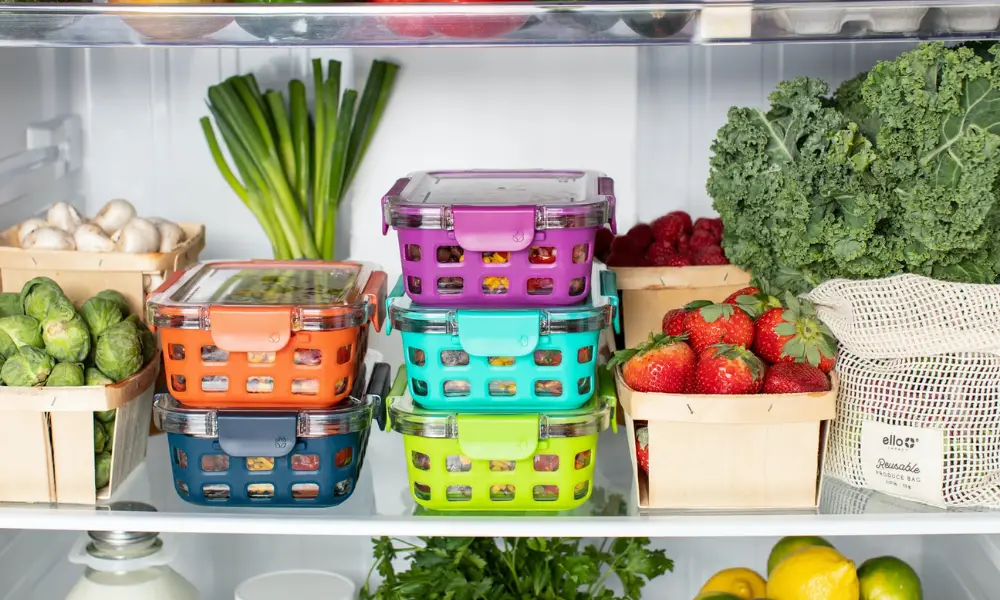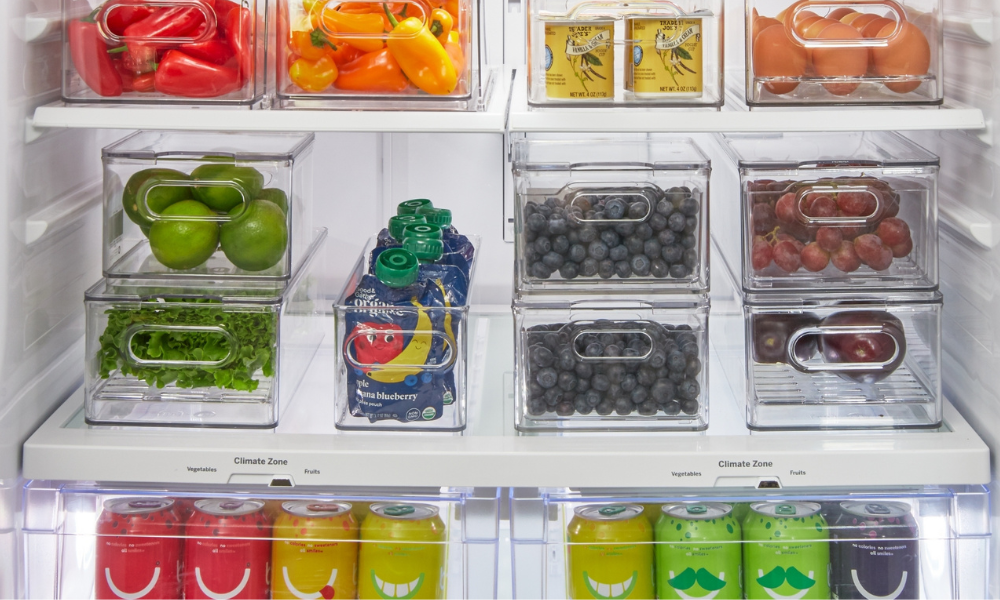Here are some steps you can take to organize your fridge. The first thing you should do is sort your stuff into categories and then label your storage bins. Next, line the drawers and shelves, so you know where to put things. Finally, keep milk and dairy-based drinks in the coldest part of your fridge.
When organizing your fridge, sorting your stuff into categories makes it easier to figure out where to start. This is also a great way to minimize waste. Some of the most common food waste culprits include leftovers, unused condiments, and expired foods. Getting rid of old food is also a good way to ensure your fridge is clean and sanitary.

How to Organize a Fridge?
- Start by emptying the refrigerator. Remove any spoiled or expired food, then use mild detergent to clean the shelves and drawers.
- Stack related objects together. Keep all the fruits in one drawer, the veggies in another, and the meats in another. This will ensure adequate food storage and make it simple to find what you need.
- Use clear containers or boxes to keep smaller goods like herbs or berries that could otherwise be lost or forgotten.
- Store less frequently used goods on higher or lower shelves, and keep regularly used items at eye level.
- Label the contents of each container or bin with a label maker or sticky notes.
- Clear containers are best for storing leftovers and cooked meals because you can easily see what’s inside.
- To ensure your refrigerator is set at the right temperature, consider using a thermometer.
- To reduce waste and maintain organization in your fridge, keep track of when you place stuff there and take out any older products.
- Use a whiteboard or spreadsheet to keep an inventory of the contents of your refrigerator. Update it frequently to track what you need to buy and what you currently own.
Why is it Necessary to Keep the Fridge Organized?
It’s crucial to keep a fridge organized for some reasons.
- Food safety: Keeping food properly refrigerated will help stop the development of dangerous bacteria that can cause food poisoning. By setting up the fridge, you can ensure that everything is kept in the right temperature zones and that any food that has gone bad can be found and thrown out immediately.
- Food Waste: It can be difficult to recognize what you already have if your refrigerator is cluttered and disorganized, resulting in overspending and food waste. The likelihood of making duplicate purchases is decreased when the fridge is organized so that it is simple to see what you already have.
- Time-saving: You’re less likely to waste time looking for ingredients or deciding what to make for supper when you can quickly see what’s in your fridge. Planning and preparing meals can be easier and more efficient if your refrigerator is organized.
- Cost-effective: You can save money on groceries by eliminating food waste. You can plan your meals appropriately and save idling costs by keeping track of the food and components you currently have.
A well-organized fridge can be aesthetically beautiful and contribute to a tranquil atmosphere in your kitchen.
How do I Maximize Space in My Fridge?
- Make use of vertical space. You may stack goods higher and make greater use of the vertical space in your fridge by using stackable containers or shelf risers. Here are some ideas to make the most of your fridge’s space:
- Use the refrigerator door as storage: The refrigerator door is sometimes disregarded as a storage area, but it may be a perfect place for products that don’t take up much space, such as condiments, jams, and jellies.
- Maintain an inventory: Meal planning should consider what is in your refrigerator. Doing so can free up room in your fridge and prevent overbuying and food waste.
- Use transparent storage containers to view what’s within without opening the container. Removing the need for many containers of the same thing can free up space.
- Save shelf space by using magnetic storage: Spices and other small objects can be stored on the refrigerator door using magnets, freeing up space on the shelves.
- Use hooks: You can hang goods like bags of greens or herbs from hooks to free up shelf space and make accessing them easier.
- Pay attention to the layout: To make greater use of the limited space, put taller goods in the back of the fridge and shorter items in the front.
- The number of leftovers you save should be considered carefully because they can take up a lot of room and may spoil.
- Use a fridge shelf organizer to keep things more organized, make finding what you need simpler, and free up space. These are made to fit on the shelves of your fridge.
What are the do’s and don’t for the Fridge?
The following are some tips for keeping your fridge efficient and organized:
Do’s:
- Maintain the refrigerator’s temperature (below 40F).
- Regularly clean the refrigerator and toss out any food that has gone bad.
- To store smaller goods, use transparent bins or containers.
- Organize comparable objects together and give them distinct labels.
- Store less frequently used goods on higher or lower shelves, and keep regularly used items at eye level.
- Clear containers should be used to store leftovers and cooked meals.
- Make sure the temperature in your refrigerator is set correctly with a thermometer.
- Keep a record of the dates you place items in the refrigerator and take out any older items.
- Keep a list of everything in your refrigerator and update it frequently.
Don’t:
- Do not overfill the refrigerator, as this may prevent cold air circulation.
- Keep warm goods out of the refrigerator since they may raise the interior temperature.
- Store uncooked or unprepared food away from raw meat and vegetables.
- Too much time spent leaving the door open can raise the temperature inside.
- Keep open cans and bottles in the refrigerator to prevent spills and odors.
- Keep produce in plastic bags so moisture can’t get trapped and spoil it quickly.
- Tomatoes, oranges, and pineapples should be kept in the refrigerator door because the temperature is often warmer there and can hasten spoiled foods’ onset.
- Keep the refrigerator overly full, hindering the flow of cold air and making the compressor work harder to maintain the desired temperature inside.
What should you Not Put in the Fridge?
Certain foodstuffs shouldn’t be kept in the refrigerator since doing so can change their flavor and texture or cause them to spoil quickly.
The following products shouldn’t be kept in the refrigerator:
- Tomatoes should be stored at room temperature to prevent wrinkling of the skin and the mealiness of the flesh from the cold temperature.
- Potatoes: Store potatoes in a cool, dry, and dark location, like a pantry or cabinet. Potato starch can convert to sugar in the frigid refrigerator, changing the flavor and texture of the food.
- Onions: Store onions away from direct sunlight and dampness in a cool, dry area. They could deteriorate quickly in the refrigerator due to dampness.
- Garlic: Store garlic in a cool, dry, and dark location, like a pantry or cabinet. The humidity in the refrigerator might lead to the sprouting or decomposition of the garlic.
- Bread: It is best to keep bread at room temperature to prevent it from drying out and losing its flavor and texture.
- Bananas should be stored at room temperature because the cold might hasten their ripening and cause them to brown.
- Melons: Until they are fully mature, melons should be kept at room temperature to prevent the cold weather from affecting their flavor and texture. Once ripe, they can be kept in the refrigerator.
- Coffee beans should be kept at room temperature, away from light and moisture, in an airtight container. The coffee’s flavor may change due to the beans absorbing aromas and absorbing refrigerator temperature and humidity.
- Oils: Oils can harden in the frigid refrigerator, becoming cloudier and more difficult to pour.
To preserve the safety and longevity of particular foods, it’s always a good idea to check the box or conduct some study on how to store them properly.
How Often Should We Clean Fridge?
A fridge should be cleaned at least once a month to keep it operating well and to avoid the growth of bacteria and odors.
Here are some general cleaning instructions for refrigerators:
- At least once a month, clean the refrigerator’s interior, including the shelves and drawers.
- Verify expiration dates and throw away any food that has gone bad.
- Warm water and a light detergent, or a solution of 1 tablespoon baking soda to 1 quart of water, should be used to clean the refrigerator’s interior.
- To get rid of any food or debris, wipe the seal surrounding the door with a moist cloth and a little detergent.
- Use a moist cloth to clean the fridge’s exterior and coils.
- Clean up spills and stains as soon as you see them to stop the formation of bacteria and odors.
- Before re-plugging, ensure the refrigerator it’s dry to avoid electrical dangers.
- It will be simpler to clean and organize your fridge if you keep track of what’s inside and arrange it in a way that makes sense. Check the owner’s manual of your refrigerator for detailed cleaning instructions since different models may have different needs.
- Furthermore, it’s a good idea to clean your fridge more frequently if it’s used frequently, if you have a lot of perishables, or if you have young children or elderly family members living with you because they are more susceptible to bacterial infections.
A convenience sample of working persons was the focus of the poll. The results of the survey’s analysis showed that efforts should be focused on enhancing microbiological control procedures. Only 37% of respondents ensured their refrigerator was set to a temperature of 4°C or lower. Just 37% of respondents said they consistently wrapped food. 89% of the respondents cleaned their refrigerator with sponges—frequently severely contaminated—indicating the necessity of advising against using sponges for cleaning. Twenty-seven per cent of the respondents admitted to using bleach. Still, they did so either without first cleaning the surface (21% of users) or using the product’s commercially available concentrated version (7% of users).
Conclusion
Before things improve, they must first get worse. To start fresh, empty your entire fridge and thoroughly clean it before you attempt to get organized.
Keep your fruits and vegetables separate and check that the humidity levels in your refrigerator’s various sectioned-off sections are set appropriately (fruits prefer lower moisture levels). Sort the food drawers separately (ideally, one for fruits and another for veggies).

